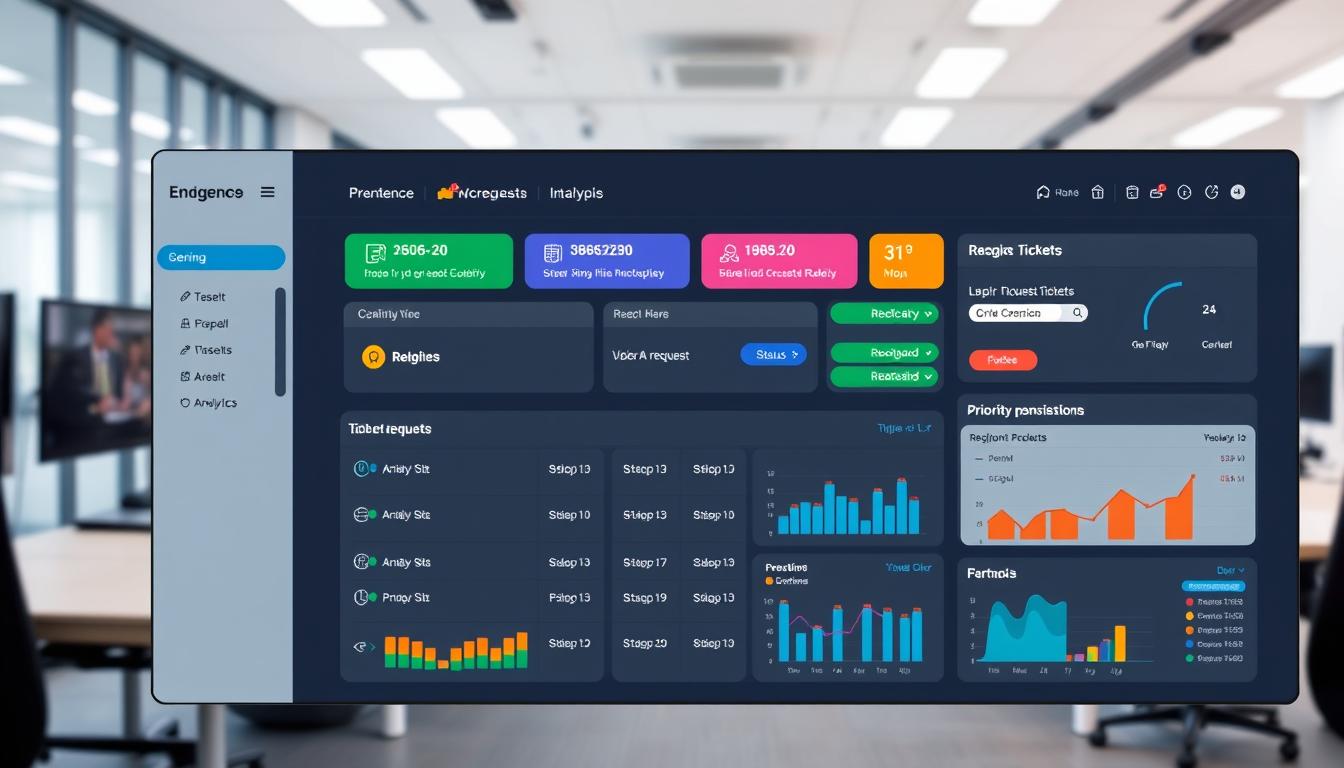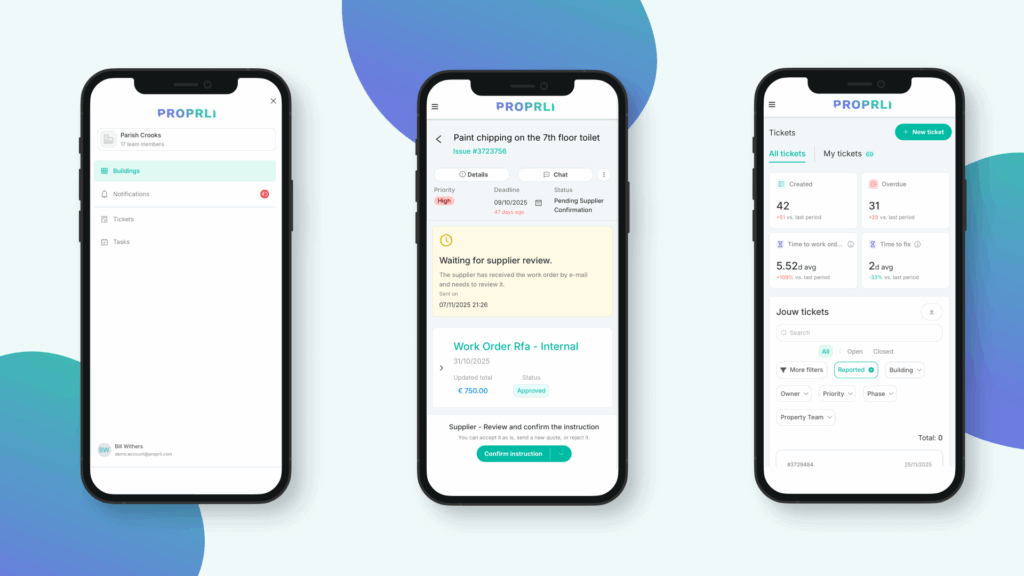In today’s fast-paced business world, efficient maintenance management is key to smooth operations and less downtime. Maintenance ticket software offers a central platform for organizing, prioritizing, and tracking repair requests. It streamlines communication between maintenance teams and facility managers. By using a robust ticket tracking system, organizations can speed up responses, cut down on errors, and boost maintenance efficiency.
Maintenance ticket software serves as a comprehensive issue management tool. It allows users to submit work requests, set priorities, and assign tasks to the right team members. This service desk platform gives maintenance managers a clear view of all outstanding repairs. It ensures critical issues are tackled quickly. By using asset management tools and facility maintenance software, organizations can refine their maintenance processes. This leads to higher productivity and cost savings.
With maintenance ticket software, managing work orders becomes a smooth process. All repair requests are gathered in one, easy-to-use interface. This centralized approach eliminates the need for manual tracking methods like sticky notes or chalkboards. It reduces the chance of lost or overlooked tasks. By digitalizing the maintenance workflow, teams can get real-time updates on repair statuses. This promotes better collaboration and communication.
Key Takeaways
- Maintenance ticket software streamlines the organization and tracking of repair requests
- Centralized platforms improve communication and collaboration among maintenance teams
- Prioritizing and assigning tasks ensures critical issues are addressed promptly
- Digitalized workflows reduce the risk of lost or overlooked repair requests
- Real-time updates on repair status foster better transparency and efficiency
The Importance of Streamlined Maintenance Management
In today’s fast-paced business environment, streamlined maintenance management is crucial for ensuring operational efficiency and minimizing downtime. By implementing a centralized platform for submitting, tracking, and managing maintenance requests, organizations can optimize their asset management processes and improve overall facility management.
Streamlining maintenance procedures helps ensure that all requests are efficiently recorded and addressed in a timely manner. This approach enables maintenance teams to prioritize tickets based on urgency and importance, minimizing the risk of potential disruptions to operations. By assigning tickets to the appropriate personnel or teams, accountability is promoted, and tasks are completed within designated timeframes.
| Traditional Maintenance Processes | Streamlined Maintenance Management |
|---|---|
| Manual work order management | Centralized digital platform |
| Lack of standardization | Consistent processes and workflows |
| Increased downtime and resource misallocation | Optimized resource utilization and reduced downtime |
| Difficulty tracking assets undergoing maintenance | Real-time asset tracking and monitoring |
The absence of a centralized work order system can lead to increased downtime and resource misallocation, negatively impacting maintenance management efforts. By implementing a streamlined maintenance management solution, organizations can benefit from:
- Enhanced communication and collaboration among maintenance teams
- Reduced operational costs and optimized resource utilization
- Data-driven decision-making for improved asset lifecycle management
- Customizable workflows tailored to specific organizational requirements
Adopting a streamlined maintenance management approach is essential for businesses looking to maximize operational efficiency, prolong asset lifespans, and drive continuous improvement in their facility management practices.
Key Features of Effective Maintenance Ticket Software
Effective maintenance ticket software must have several key features to streamline operations and boost efficiency. A centralized ticket management system is crucial, organizing all repair tickets in one place. This makes it easy to access, prioritize, and track maintenance tasks. It ensures no work orders are lost and improves communication between requestors and technicians.
A customizable workflow is another essential feature, allowing organizations to tailor the software to their specific needs. This flexibility optimizes maintenance workflows, reducing downtime and increasing productivity. Inventory management is also vital, tracking parts used in repairs and monitoring stock levels. This results in an average cost savings of 23% due to efficient procurement and timely replenishment.
In today’s fast-paced world, mobile accessibility is a must-have for maintenance ticket software. Mobile and tablet apps enable full-cycle repair management and quick product sales on mobile devices. This increases operational agility by 38% and reduces asset downtime by 22% in the field. Automated notifications also keep clients informed about their repair status, enhancing the customer experience and fostering trust.
| Feature | Benefit | Industry Impact |
|---|---|---|
| Centralized Ticket Management | Streamlined maintenance processes | 84% of organizations consider it critical |
| Customizable Workflow | Tailored to unique business needs | Reduces downtime and increases productivity |
| Inventory Management | Efficient procurement and replenishment | Average cost savings of 23% |
| Mobile Accessibility | Full-cycle repair management on mobile devices | Increases operational agility by 38% |
| Automated Notifications | Enhances customer experience | Keeps clients informed and fosters trust |
These key features, when combined, create a powerful tool for managing maintenance operations across various industries. This includes K-12, higher education, government, manufacturing, property management, religious organizations, restaurants, zoos, healthcare, non-profit, and education sectors. By leveraging these features, organizations can improve communication, resolve issues faster, and optimize their maintenance processes for long-term success.
Benefits of Implementing a Maintenance Ticketing System
Introducing a maintenance ticketing system brings numerous advantages to organizations. It streamlines maintenance processes, boosts productivity, and enhances operational efficiency. Automation and centralized management help overcome common challenges, ensuring maintenance goals are met effectively.
One key benefit is increased productivity. A structured maintenance approach allows technicians to quickly resolve issues. This minimizes downtime and maximizes efficiency. Automation and easy access to information enable technicians to work more effectively.
Improved communication is another significant advantage. A centralized platform connects technicians, managers, and clients. Real-time updates and collaborative features ensure everyone is informed, reducing misunderstandings.
Maintenance ticketing systems also enhance customer service. They track customer information and history, offering personalized service. Automated notifications and real-time updates keep customers informed, boosting satisfaction and loyalty.
| Benefit | Percentage of Organizations |
|---|---|
| Increased efficiency and productivity | 25% |
| Improved communication and collaboration | 20% |
| Enhanced customer satisfaction | 91% |
| Reduced human error | 30% |
| Compliance with regulatory standards | 83% |
Reducing human error is a major benefit. Manual data entry is eliminated, and a structured framework is followed. Automated data capture and reporting ensure accurate information, supporting better decision-making.
Performance tracking is crucial, and ticketing systems provide valuable insights. They analyze shop performance, identifying areas for improvement. Data-driven decision-making leads to proactive maintenance strategies.
In summary, maintenance ticketing systems offer many benefits. They increase productivity, improve communication, enhance customer service, reduce errors, and track performance. These advantages streamline maintenance operations, improving efficiency and driving success in maintenance management.
Choosing the Right Maintenance Ticket Software for Your Organization
When picking a maintenance ticket software, several key factors must be considered. Scalability is paramount, as your business grows and evolves. Your software should handle increasing demands and complexities. Look for flexible pricing plans and adaptability to your changing needs.
Ease of use is also critical. The software should have an intuitive interface for both experienced and new users. A user-friendly design reduces training needs and boosts adoption across your organization. Opt for software with clear menus and straightforward workflows to simplify maintenance processes.
Integration capabilities are vital when selecting software. It should integrate smoothly with your existing systems, like accounting software and messaging platforms. This ensures data consistency, reduces manual entry, and offers a comprehensive view of maintenance operations. Assess the software’s integrations and API support for compatibility with your technology stack.
Customization options are another key factor. Every organization has unique maintenance processes and requirements. Choose software that allows for significant customization. This includes customizable fields, templates, and workflows to capture relevant data and streamline communication.
Lastly, consider industry-specific features. Some software offers specialized functionalities for industries like manufacturing or healthcare. These features may include compliance tracking and regulatory reporting. Ensure the software meets your industry’s specific challenges and supports best practices.
By evaluating scalability, ease of use, integration, customization, and industry-specific features, you can find the right maintenance ticket software. This ensures it meets your organization’s unique needs and drives success.
Best Practices for Implementing and Utilizing Maintenance Ticket Software
To fully benefit from maintenance ticket software, it’s vital to adhere to best practices. Thorough staff training is key to ensure all team members are proficient in using the software. This understanding of its features and benefits boosts adoption rates and enhances maintenance efficiency.
Optimizing processes is another crucial step in successful implementation. Analyzing maintenance trends helps identify areas for improvement. Regular software updates are also essential to leverage new features and enhancements, further optimizing maintenance management.
Data-driven decision making is critical in effective software utilization. Maintenance managers can gain insights into operations through reporting and analytics tools. This enables informed decisions, identifying bottlenecks and prioritizing tasks effectively.
| Best Practice | Impact on Maintenance Management |
|---|---|
| Staff Training | Increases adoption rates and improves efficiency |
| Process Optimization | Streamlines processes and reduces inefficiencies |
| Regular Updates | Ensures access to new features and enhancements |
| Data-Driven Decision Making | Enables informed decisions based on real-time data |
| Continuous Improvement | Fosters a culture of ongoing refinement and optimization |
Lastly, cultivating a culture of continuous improvement is vital for long-term success. Regularly reviewing and refining processes based on data insights ensures maintenance operations remain efficient and effective. This approach fosters ongoing refinement and optimization.
Leveraging Data Analytics for Continuous Improvement
Data analytics is now crucial for optimizing maintenance processes and driving continuous improvement. It helps companies spot trends, recurring issues, and ways to better allocate resources. This leads to better performance metrics and increased efficiency.
Data analytics in maintenance management offers a significant advantage. It allows for analyzing historical data to find patterns and areas for improvement. By looking at past maintenance records, companies can spot recurring issues and tackle them before they become major problems. This approach reduces downtime and cuts down on costly repairs and replacements.
Another key benefit of data analytics in maintenance is optimizing resource allocation. By examining data on staff usage, material consumption, and equipment performance, organizations can make better decisions. This ensures the right resources are used at the right time, boosting efficiency and saving costs.
| Data Analytics Technique | Application in Maintenance |
|---|---|
| Predictive Analytics | Forecasting equipment failures and maintenance needs |
| Descriptive Analytics | Generating real-time insights into maintenance operations |
| Prescriptive Analytics | Recommending optimal maintenance actions based on data |
To gauge the success of data analytics in maintenance, tracking key performance metrics is essential. These metrics include traditional measures like equipment uptime and maintenance costs. They also include advanced indicators like energy efficiency and environmental impact. By monitoring these metrics, companies can see how well their data analytics efforts are working and where they need to improve.
The true power of data analytics in maintenance management is its ability to provide actionable insights. These insights drive continuous improvement by helping organizations make informed decisions. By using data analytics, companies can optimize their maintenance processes, reduce costs, and improve overall operational efficiency.
Integrating Maintenance Ticket Software with Other Maintenance Management Tools
Integrating maintenance ticket software with other tools significantly boosts maintenance efficiency. By linking systems like CMMS, ERP, and IoT sensors, organizations can manage assets and predict maintenance needs more effectively. This approach streamlines maintenance operations, leading to better asset management and predictive maintenance.
CMMS integration with maintenance ticket software centralizes and prioritizes maintenance tasks. It feeds real-time data from equipment into the CMMS, helping teams quickly address potential issues. This proactive maintenance extends asset life, reduces downtime, and optimizes resource allocation.
ERP integration with maintenance ticket software aligns maintenance with business goals. It connects financial and operational data, offering a comprehensive view of asset performance. This integration also improves inventory management and procurement, ensuring timely availability of parts and materials.
IoT sensors enhance predictive maintenance capabilities. They monitor equipment parameters like temperature and vibration, detecting anomalies and triggering maintenance tickets. This early detection minimizes downtime and extends asset life.
| Integration Type | Benefits |
|---|---|
| CMMS Integration |
|
| ERP Integration |
|
| IoT Sensor Integration |
|
Integrating maintenance ticket software with asset management tools offers a comprehensive view of asset performance. It tracks asset data throughout its lifecycle, optimizing maintenance strategies and reducing costs. This approach improves equipment effectiveness and reduces total cost of ownership.
Seamless integration of maintenance management tools enhances efficiency and decision-making. It breaks down data silos, enabling real-time information sharing. This empowers maintenance teams to work more efficiently, leading to increased uptime, reduced costs, and improved operational performance.
The Future of Maintenance Ticket Software
As technology advances, the future of maintenance ticket software is bright. Artificial intelligence and machine learning will change how we manage maintenance. Predictive analytics will help predict maintenance needs, optimizing resource use. This will keep companies ahead of problems and reduce downtime.
Augmented reality is another exciting trend. It will offer technicians real-time support, making maintenance more efficient. They’ll get step-by-step instructions and visual aids on their devices or glasses.
The rise of mobile devices has led to a mobile-first approach in software development. Future maintenance ticket software will focus on mobile users. It will have easy-to-use interfaces and work well on different devices. This will let maintenance teams work on the go, ensuring quick collaboration and response times.
| Technology | Impact on Maintenance Ticket Software |
|---|---|
| Artificial Intelligence | Enables predictive maintenance and optimizes resource allocation |
| Machine Learning | Improves accuracy and efficiency of maintenance processes |
| Predictive Analytics | Anticipates maintenance needs and minimizes downtime |
| Augmented Reality | Provides real-time guidance and support for technicians |
| Mobile-First Approach | Enhances accessibility and usability for mobile users |
The future of maintenance ticket software will make operations more efficient. It will change how organizations manage maintenance. By using advanced technologies and focusing on mobile, companies can lead the way. Maintenance ticket software will become even more vital for modern maintenance management.
Maintenance Ticket Software: A Critical Tool for Modern Maintenance Management
In today’s fast-paced business environment, organizations are constantly seeking ways to optimize their maintenance processes and gain a competitive advantage. Maintenance ticket software has emerged as a critical tool for modern maintenance management. It enables companies to streamline their operations, improve efficiency, and drive continuous improvement. By embracing digital transformation and adopting a customer-centric approach, businesses can leverage maintenance ticket software to achieve operational excellence and enhance customer satisfaction.
One of the key benefits of implementing maintenance ticket software is its ability to provide a centralized platform for managing maintenance requests, work orders, and asset information. This centralization enables better communication and collaboration among maintenance teams, reducing the risk of missed or delayed repairs. By automating workflows and prioritizing tasks based on urgency and impact, maintenance ticket software helps organizations respond quickly to maintenance issues. This minimizes downtime and ensures optimal equipment performance.
Moreover, maintenance ticket software empowers organizations to adopt a proactive approach to maintenance management. By leveraging data analytics and insights generated by the software, maintenance teams can identify patterns, predict potential failures, and schedule preventive maintenance tasks accordingly. This shift from reactive to predictive maintenance not only extends the lifespan of assets but also reduces overall maintenance costs and improves operational efficiency.
| Benefit | Description |
|---|---|
| Increased Productivity | Streamlined workflows and automated processes enable maintenance teams to complete tasks more efficiently |
| Improved Communication | Centralized platform facilitates seamless communication and collaboration among maintenance personnel |
| Enhanced Customer Service | Quick response to maintenance requests and proactive maintenance approach lead to higher customer satisfaction |
| Reduced Human Error | Automated data entry and standardized processes minimize the risk of manual errors and inconsistencies |
| Performance Tracking | Real-time data and analytics provide valuable insights into maintenance performance and areas for improvement |
Another critical aspect of maintenance ticket software is its ability to support a customer-centric approach. By providing a user-friendly interface for submitting maintenance requests and tracking their progress, organizations can enhance the customer experience and build trust. Timely communication and transparent status updates keep customers informed and engaged, leading to increased satisfaction and loyalty.
As organizations embark on their digital transformation journeys, maintenance ticket software becomes an indispensable tool for driving operational excellence and continuous improvement. By embracing this technology and integrating it with other maintenance management systems, businesses can unlock new efficiencies, optimize resource allocation, and make data-driven decisions. These decisions propel them ahead of the competition.
Conclusion
This article has highlighted the crucial role of maintenance ticket software in organizing repair requests efficiently. It streamlines maintenance management processes, offering numerous benefits. These include faster issue resolution, improved customer satisfaction, and better collaboration among support staff. Automation of ticket routing and reduced manual intervention also boost efficiency in resolving issues.
Maintenance ticket software provides valuable analytics for identifying common issues and monitoring performance. Managers can track ticket volume, monitor key performance indicators, and allocate resources more effectively. Detailed reports help identify trends, bottlenecks, and areas for improvement, enabling continuous optimization of maintenance management processes.
As businesses aim for operational excellence and continuous improvement, evaluating current maintenance management practices is essential. Adopting maintenance ticket software can drive productivity, improve communication, enhance customer service, and reduce human error. It offers valuable insights into performance. We encourage readers to explore available maintenance ticket software options and revolutionize their maintenance management approach.
Embracing maintenance ticket software is not optional; it’s a necessity for modern businesses aiming to thrive. These tools unlock new levels of efficiency, streamline processes, and deliver exceptional customer service. The future of maintenance management depends on those willing to adapt, innovate, and leverage the latest technologies for operational excellence and continuous improvement.
FAQ
What is maintenance ticket software?
Maintenance ticket software is a tool designed to help organizations manage and track repair requests efficiently. It streamlines communication, prioritizes issues, and ensures timely completion of maintenance tasks.
How can maintenance ticket software benefit my organization?
Implementing maintenance ticket software can increase productivity and improve communication. It enhances customer service, reduces human error, and tracks performance better. It optimizes maintenance processes, minimizes downtime, and ensures efficient handling of repair requests.
What are the key features to look for in maintenance ticket software?
Look for centralized ticket management, customizable workflows, and inventory management in maintenance ticket software. Mobile accessibility and automated notifications are also crucial. Scalability, ease of use, integration capabilities, customization options, and industry-specific features are important aspects to consider.
Can maintenance ticket software integrate with other maintenance management tools?
Yes, many maintenance ticket software solutions integrate with CMMS, ERP systems, and IoT sensors. These integrations enable predictive maintenance, asset management, and a comprehensive view of maintenance operations.
How can I ensure successful implementation and adoption of maintenance ticket software?
Ensure successful implementation by providing thorough staff training and optimizing processes with data insights. Keep the software updated and foster a culture of continuous improvement. Regularly review and refine maintenance processes based on data analytics to drive operational excellence.
What are the future trends in maintenance ticket software?
The future of maintenance ticket software includes artificial intelligence, machine learning, predictive analytics, and augmented reality. There will be a focus on mobile-first approaches to cater to mobile device usage in maintenance management. These advancements will optimize maintenance processes and enhance operational efficiency.
How can maintenance ticket software help my organization gain a competitive advantage?
Maintenance ticket software can help organizations optimize maintenance processes, improve operational efficiency, and enhance customer satisfaction. By leveraging data-driven insights and adopting a customer-centric approach, organizations can achieve operational excellence and differentiate themselves in their industries.
What role does maintenance ticket software play in modern maintenance management?
Maintenance ticket software is a critical tool for modern maintenance management and digital transformation initiatives. It streamlines processes, improves communication, reduces downtime, and enables data-driven decisions. By embracing maintenance ticket software, organizations can drive continuous improvement and achieve operational excellence in their maintenance management practices.






